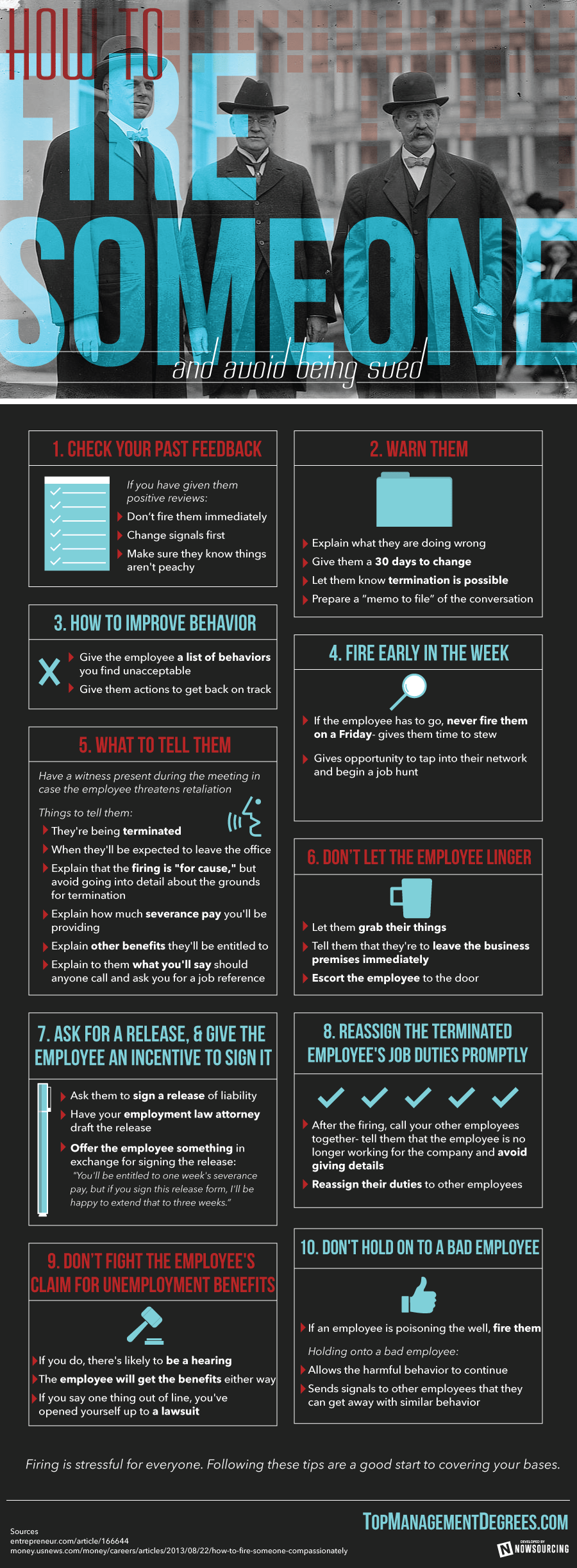How to Fire Someone and Avoid Being Sued
Firing someone is something nobody wants to have to do, but if its necessary, do it right.
1. Check your past feedback.
â— If you have given them positive reviews:
â—‹ Don't fire them immediately
â—‹ Change signals first
â—‹ Make sure they know things aren't peachy
2. Warn them
â— Explain what they are doing wrong
â— Give them a period of time to change
â—‹ 30 days
â— Let them know termination is possible
â— Prepare a "memo to file" of the conversation
3. How to improve behavior
â— Give the employee a list of behaviors you find unacceptable
â— Give them actions to get back on track
4. Fire early in the week
â— If the employee has to go, never fire them on a Friday
â—‹ Gives them time to stew
â— Fire them early in the week
â—‹ Gives opportunity to tap into their network and begin a job hunt
5. Make it concise
â— Do not get caught up in emotions.
â—‹ Have a witness present during the meeting in case the employee threatens retaliation.
â—‹ Things to tell them:
â– They're being terminated
â– When they'll be expected to leave the office
â– Explain that the firing is "for cause," but avoid going into detail about the grounds for termination.
â– Explain how much severance pay you'll be providing
â– Explain other benefits they'll be entitled to
â– Explain to them what you'll say should anyone call and ask you for a job reference.
â—‹ Be sure you've spoken with an employment law attorney first and have agreed on the exact wording.
6. Do not let the employee linger.
â— Let them grab their things
â— Tell them that they're to leave the business premises immediately
â— Escort the employee to the door
â—‹ Takes away chance employee could
â– Steal any company files
â– Trash any computer data
â– Change any computer passwords
â—‹ Before the meeting is over have another employee revoke access to computer
â—‹ Collect any office keys and company credit cards
7. Ask for a release, and give the employee an incentive to sign it.
â— If the employee is a:
â—‹ minority
â—‹ female
â—‹ over the age of 40,
â— Ask them to sign a release of liability
â— Have your employment law attorney draft the release
â— Offer the employee something in exchange for signing the release:
â—‹ "You'll be entitled to one week's severance pay, but if you sign this release form, I'll be happy to extend that to three weeks."
8. Reassign the terminated employee's job duties promptly.
â— After the firing, call your other employees together
â—‹ Tell them that the employee is no longer working for the company
â– Avoid giving details
â—‹ Reassign their duties to other employees.
9. Do not fight the employee's claim for unemployment benefits.
â— If you do, there's likely to be a hearing
â— The employee will get the benefits either way
â— If you say one thing out of line, you've opened yourself up to a lawsuit
10. Get the job done.
â— If an employee is poisoning the well fire them
â— Holding onto a bad employee
â—‹ Allows the harmful behavior to continue
â—‹ Sends signals to other employees that they can get away with similar behavior
Firing an employee is very difficult, and there's no guarantee you won't be sued, but these steps are a good start to covering your bases.
Sources:
http://money.usnews.com/money/careers/articles/2013/08/22/how-to-fire-someone-compassionately
http://www.entrepreneur.com/article/166644

